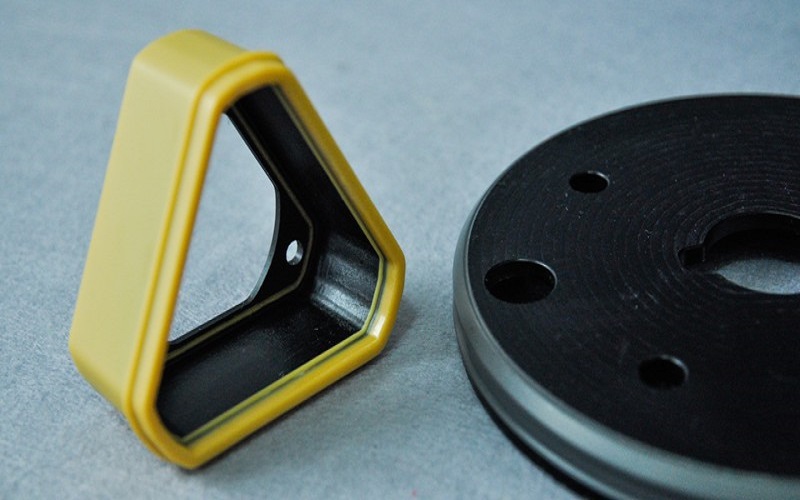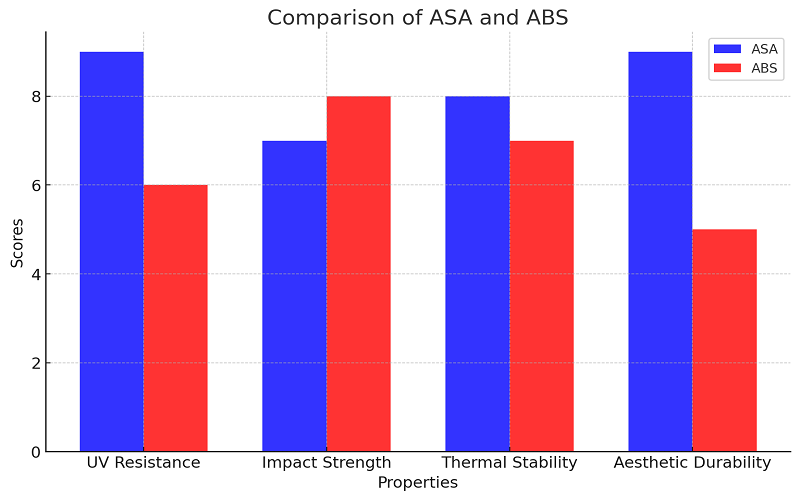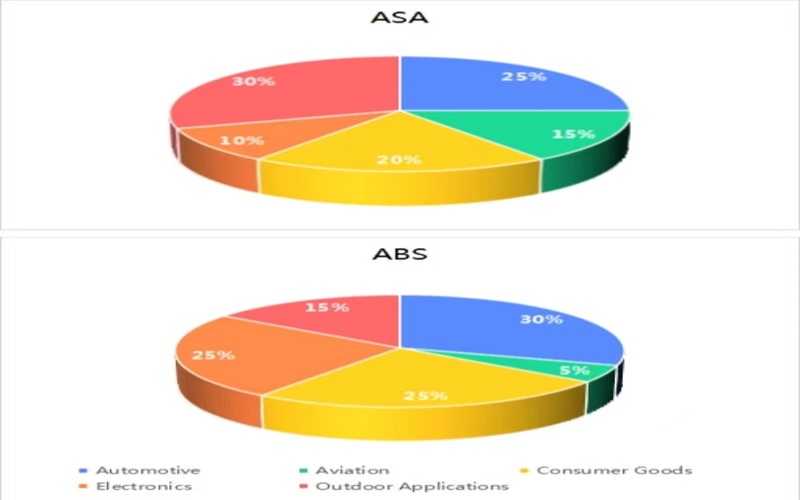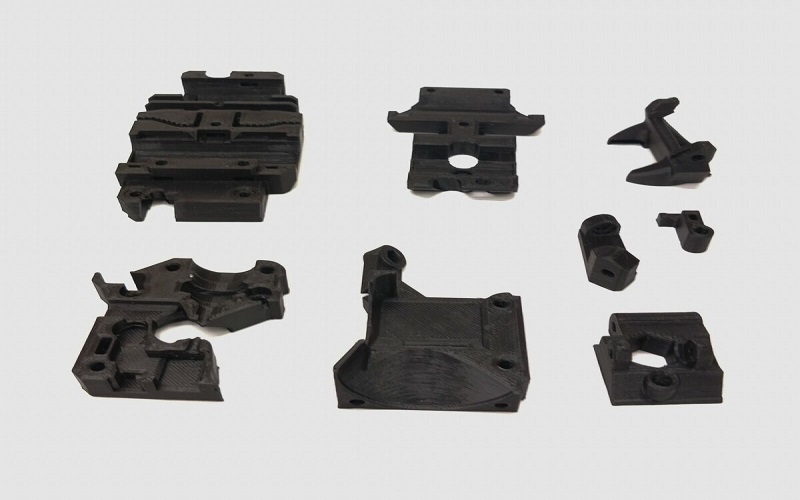In the numerous plastic applications where mechanical strength and stiffness are essential, ASA and ABS are often the materials of choice.
Although they share similar attributes in many aspects, they also possess their unique performance advantages.
Therefore, deciding between these two types of plastic materials has become a critically important issue.
In the following content, we will delve into the performance of these two materials and comprehensively evaluate their performance in specific application scenarios.
Overview of ASA And ABS Plastic
ABS plastic is a terpolymer made from acrylonitrile (A), butadiene (B), and styrene (S), combining the properties of PB, PAN, and PS to create a material with a balanced set of mechanical characteristics that are tough, hard, and rigid.
In contrast, ASA is formed by copolymerizing styrene, acrylonitrile, and acrylate rubber.
Compared to ABS, ASA significantly improves weather resistance by substituting butadiene rubber with acrylate rubber, which lacks double bonds.
Technically, ASA not only retains the main properties of ABS but also incorporates the weather resistance advantages of PMMA plastic, extending its application to outdoor uses.

ASA vs ABS:Properties Comparison

The substitution of rubber double bonds plays a pivotal role in defining the subtle yet significant differences in performance between ASA and ABS.
Consequently, a thorough comparison of the properties of these two materials is warranted.
- Mechanical Properties
ABS is celebrated for its robust mechanical strength and stiffness, making it suitable for durable products, alongside notable impact resistance, even in cold environments.
ASA shares these strengths but stands out for its enhanced toughness and better integrity under UV exposure, especially in outdoor settings.
- Thermal Properties
In terms of heat resistance, ASA and ABS are relatively similar, with ABS having a heat distortion temperature of 93~118°C and still displaying some toughness at -40°C.
ABS and ASA both exhibit good thermal stability during processing, but ASA’s enhanced resistance to UV light can translate to better long-term thermal stability in outdoor applications.
- Weatherability
Outstanding UV resistance and anti-aging capabilities mark a significant advantage of ASA and represent one of its largest differences from ABS plastic.
ASA can withstand degradation, aging, and fading caused by UV exposure, while also offering robust protection against decomposition or discoloration due to oxidation in the atmosphere and high temperatures during processing.
- Aesthetic and Finishing Options
ASA contains modifiers in its composition that enhance its resistance to UV-induced fading and yellowing, making it more suitable for applications where long-term aesthetic appeal is important.
The acetone smoothing method, known for achieving a high-gloss surface effect on ABS, is equally applicable to ASA materials. ASA injection molding products do not require painting, plating, or other surface protection and can be used outdoors directly.

ASA vs ABS:Analysis Of Application Areas
In the realm of 3D printing, ASA and ABS each have their own distinct applications.
As we’ve mentioned, one of the main attractions of ABS is its technical nature, which tends to steer its applications towards industrial uses.
For instance, ABS injection molding is a currently popular plastic manufacturing process.
Additionally, for general purposes, it can be found in home appliances, hulls, decorative items, toys, and the renowned LEGO bricks.
In additive manufacturing, its other common uses include prototyping, gears, and even tools, as it offers better resistance to physical stress than some other common 3D printing polymers.
Its electrical insulation properties also make it attractive for those looking to manufacture casings for electrical components, as well as automotive parts like dashboards or bumpers.
However, the major drawback of ABS is the intense fumes produced during printing, accompanied by issues like warping, hence it’s recommended to print in well-ventilated areas.
On the other hand, ASA boasts strong UV and impact resistance, making it suitable for various outdoor installations such as signage, sports equipment, and automotive exterior applications.
ASA is the preferable choice for tools that require durability and stability in everyday use.
Yet, printing with ASA typically demands higher extrusion temperatures, and it is pricier compared to ABS, necessitating a balance between cost and application needs when selecting plastic materials.

ASA vs ABS:Safety Factor
As the application scope of ASA and ABS continues to expand, concerns about safety hazards in plastic products have arisen: Is ASA toxic? Is ABS safe?
Due to its unique structure, ASA offers similar chemical resistance to ABS but with better weatherability and UV resistance, which can translate into better long-term performance and safety in outdoor applications.
ASA’s fire resistance is about ten times higher than that of ABS, with a fire rating of B1 level, meeting the basic fire protection requirements for residential housing, which ABS does not achieve.

In terms of health and environmental safety, ABS does not contain any known carcinogens and is generally considered non-toxic when it is in its solid form.
Therefore, it is recommended to use ABS in well-ventilated areas and follow safety guidelines to minimize exposure to these emissions.
Additionally, ABS’s composition allows it to be recycled, reducing its environmental impact compared to materials that cannot be easily processed for reuse.
ABS has been noted to emit styrene during printing, a VOC with potential health risks in poorly ventilated spaces, while ASA is often regarded as having a less intense odor but still requires proper safety measures.
Despite its lower UV and weather resistance compared to ASA, ABS remains a popular choice for indoor applications where these factors are less critical, and its use continues to be supported by ongoing research and improvements in plastic formulation and processing techniques to enhance its safety profile.

Conclusion
Overall, both ASA and ABS are versatile thermoplastic polymers that, despite their similarities, possess unique characteristics to meet different application needs.
ASA is renowned for its outstanding weatherability and UV resistance, making it highly suitable for outdoor use where it can maintain its color and physical properties over extended exposure to natural elements.
ABS, known for its high impact strength and mechanical robustness, is the material of choice for consumer goods, automotive parts, and electronic housings.
While both materials have the drawback of emitting fumes during processing, especially in 3D printing, this issue can be mitigated with appropriate safety measures.
This comparison highlights the key differences between ASA and ABS; for more insights into plastic materials, stay tuned to FOWMOULD!
